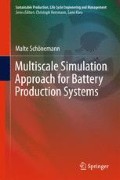Abstract
The developed multiscale simulation concept is exemplary applied to two different battery production systems. The purpose of this application is demonstrating the use of the simulation concept, the core model, the development of detailed models, as well as the interpretation of simulation results. Since the simulation is applicable for all production stages and different objectives, the application is demonstrated for cell production (Sect. 6.1) as well as for the assembly of battery modules (Sect. 6.2).
Access this chapter
Tax calculation will be finalised at checkout
Purchases are for personal use only
Notes
- 1.
The BLB was established in 2013 at the Technische Universität Braunschweig as an institution of the Automotive Research Centre Niedersachsen (NFF); www.tu-braunschweig.de/blb.
- 2.
The fan has a nominal power of 11 kW but it mostly operates at 30% of this power. The filter requires compressed air. The purpose of the chiller is cooling of the exhaust air before entering the filter. The chiller has a nominal power of 65 kW. Its power demand depends on the outside air temperature. Since no exact energy data exist so far, a template for a function was implemented which can initially be used for a rough estimation of the chiller power demand and later be adapted.
- 3.
It is possible to implement existing worker performance models (e.g. from Baines et al. 2004) into a multiscale simulation if the results are expected to be beneficial.
- 4.
The open-source toolbox was developed by the Building Physics research group of the Chalmers University of Technology in Gothenburg, Sweden and the Department of Civil Engineering from Technical University of Denmark in Copenhagen. The resources and information are available on www.ibpt.org.
- 5.
For each zone: 8 kW in operation and 5 kW in standby mode.
- 6.
It was assumed that heat supply is available throughout the entire year although it might be turned off during summer months.
- 7.
The model determines the required cooling demand to maintain the zone temperature in the desired range. However, in the BLB, the capacity of the available chiller is not large enough to supply the dry room AHU as we as to provide cooling for all zones.
- 8.
Measurements were only available for April, August, September and October.
- 9.
Approximately 7 m\(^3\)/h. However, due to the lack of sufficient data, this aspect is neglected in the model so far.
- 10.
Goodness of fit: R-square: 0.8496. The quality of this fit has to be re-evaluated if more data samples are available.
- 11.
Further studies could deal with the measurement of the zone dew point temperature along with the number of people inside a dry room over a time period. This may enable to derive a regression function for the power demand depending on moisture loads.
- 12.
Since there is no established series production scenario of the BLB, this reference scenario represents one exemplary system configuration which is not necessarily completely representative for the BLB.
- 13.
Each run starts with empty buffers and consequently not in steady state. In addition, stochastic effects such as machine failures or process variations are neglected due to the lack of required data.
- 14.
- 15.
In this case study, the term workstation was used since assembly tasks are often manual tasks which are supported by different tools or resources.
- 16.
The processing times are defined based on assumptions and serve the purpose of demonstration. They do not reflect real-word production data.
References
G. Posselt. Towards Energy Transparent Factories. Sustainable Production, Life Cycle Engineering and Management. Springer International Publishing, 2016. ISBN 978-3-319-20868-8. doi:10.1007/978-3-319-20869-5.
T. Baines, S. Mason, P. O. Siebers, and J. Ladbrook. Humans: The missing link in manufacturing simulation? Simul. Model. Pract. Theory, 12(7-8 SPEC. ISS.):515–526, 2004. ISSN 1569190X. doi:10.1016/S1569-190X(03)00094-7.
DWD. Testreferenzjahre (TRY) (web page, accessed 2016-03-28), 2016. URL http://www.dwd.de/DE/klimaumwelt/klimaforschung/spez_themen/try/try_node.html.
Umweltbundesamt. Entwicklung der spezifischen Kohlendioxid- Emissionen des deutschen Strommix in den Jahren 1990 bis 2014, 2015.
Umweltbundesamt. Emissionsbilanz erneuerbarer Energieträger - Bestimmung der vermiedenen Emissionen im Jahr 2012 (Emission balance of renewable energies - determination of avoided emissions in 2012), 2013.
M. Schönemann, P. Greschke, C. Herrmann, and S. Thiede. Simulation of matrix-structured manufacturing systems. J. Manuf. Syst., 37:104–112, 2015. doi:10.1016/j.jmsy.2015.09.002.
Author information
Authors and Affiliations
Corresponding author
Rights and permissions
Copyright information
© 2017 Springer International Publishing AG
About this chapter
Cite this chapter
Schönemann, M. (2017). Exemplary Application. In: Multiscale Simulation Approach for Battery Production Systems. Sustainable Production, Life Cycle Engineering and Management. Springer, Cham. https://doi.org/10.1007/978-3-319-49367-1_6
Download citation
DOI: https://doi.org/10.1007/978-3-319-49367-1_6
Published:
Publisher Name: Springer, Cham
Print ISBN: 978-3-319-49366-4
Online ISBN: 978-3-319-49367-1
eBook Packages: EngineeringEngineering (R0)

